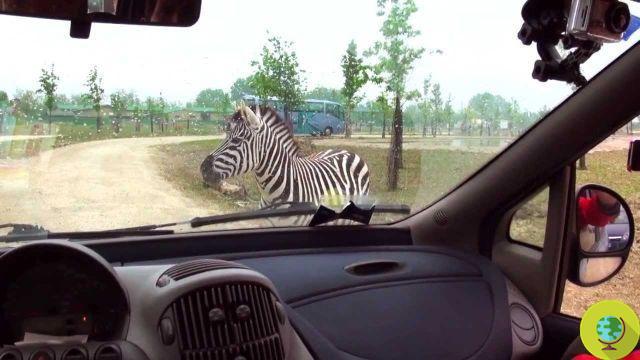
At the Ravenna Safari Zoo there are over 450 animals on display to the public who can observe them from their own car or with a special train. These are antelopes, bison, camels, red deer, fallow deer, dromedaries, emus, flamingos, wildebeest, llamas, Highland cows, scimitar-horned oryx, ostriches, yaks, zebras. But also baboons, giraffes, lions and tigers.
He is about to end up run over, his mother saves him
At the Ravenna Safari Zoo there are over 450 animals, exposed to the public who can observe them from their own car or with a special train. These are antelopes, bison, camels, red deer, fallow deer, dromedaries, emus, flamingos, wildebeest, llamas, Highland cows, scimitar-horned oryx, ostriches, yaks, zebras. But also baboons, giraffes, lions and tigers.
They are contained either by the external fence, which delimits the entire area or are confined in more limited spaces circumscribed by fences and moats. Some are placed inside an aviary, such as baboons, which must be accessed with another special train. Not satisfied with its diverse population of inmates, the safari zoo is set to expand and plans to open a reptile house this season with crocodiles, iguanas, pythons, boas, monitor lizards and an aquarium for fish and crustaceans.
The birth of this zoo, from a legal point of view, is due to the possession of the requisites that the law now requires of zoos, namely the pursuit of some didactic and scientific purposes. A visit to the Ravenna safari zoo, however, shows all the commercial side of this structure: animals exhibited among rows of cars, completely inserted in a context certainly not suited to them and condemned, in a succession of monotonous and without stimuli, time. to that meaningless life that zoos reserve.
It reveals it an investigation by Being Animals, supported by the statements of ethologists, biologists and psychologists of undisputed competence and carried out in the spring of 2013 inside the Ravenna safari zoo in the structure adjacent to the Mirabilandia amusement park. Here, in fact, all the specimens, which come from from previous captive conditions, from circuses, other zoological gardens, such as the Fasano safari zoo in the province of Brindisi, live daily under stress and are specially exposed to anthropogenic interference, without any possibility of sheltering and hiding from the public gaze because without vegetation (which would cover the sight of animals to tourists)
“What struck us most was the aviary where baboons are confined, adjacent to the refreshment area from where deafening music comes and certainly annoying for these animals. As soon as the guided tour begins baboons storm the train, to receive chips and popcorn that visitors offer them while the zoo staff urges them to feed them ”, explain the activists, who also filmed the only elephant detained constantly rocking its body, a sign of severe physical and psychological discomfort.
Not even parrots and birds of prey are spared. They are employed in shows presented as didactic meetings, which consist of forcing animals to performing exercises and acrobatics or being chained to the arm of a zoo operator. "Such performances follow a mentality based on a relationship that does not respect their ethological needs", continue the animal rights activists.
Most animals do presents notably apathetic, without reactions, in a state of general indifference that seems habitual. This is probably due to the lack of stimuli that confinement in zoos entails and from the past of captivity of these animals, overexposed to the human presence to the point of desensitization to it. What is didactic and educational about all this? A cage, large or small, remains a cage.
Roberta Ragni


























